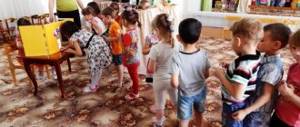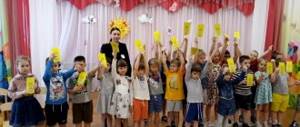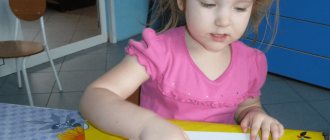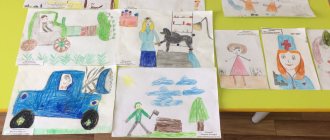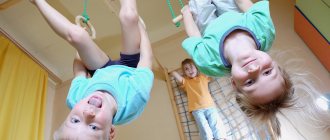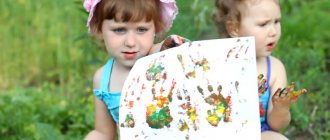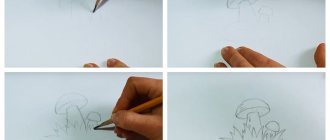What you need for an applique on the theme of mushrooms and berries made from paper
Materials you will need for this work:
- a sheet of cardboard as a base;
- several sheets of colored paper in different colors;
- printable templates for coloring and cutting out;
- scissors;
- oilcloth;
- glue;
- napkins;
- colour pencils.
What to do to prepare for class:
- Print out drawings of the outlines of the finished mushrooms.
- On sheets of colored paper, draw blanks of different sizes for legs (rectangles, squares), caps (circles). The colors of the legs and caps are different. It is good if they are close to the natural colors that are shown to children in pictures during the lesson.
- Prepare sheets of cardboard or thick paper that will serve as the basis for the craft.
- If you are planning a group lesson, make sure that the children have the same sets of materials.
- Make a sample that will be shown to the children at the beginning.
To make a kindergarten lesson interesting for children, the teacher should include poems, riddles, and jokes that contain words on the topic in the lesson notes. It’s a good idea to print these materials out in advance so you have them on hand.
GCD in the 2nd junior group “Mushrooms for the squirrel”
Summary of direct educational activities in the 2nd junior group
Topic: “Mushrooms for squirrels”
Integration of educational areas:
“Cognitive development”, “Speech development”, “Physical development”, “Artistic development”.
Target:
expand children's understanding of natural objects; develop creative abilities.
Tasks:
Educational: expand ideas about natural objects;
show in an accessible form the dependence of the life of flora and fauna on environmental conditions;
promote the memorization of small works of art, reproduce them;
the ability to determine quantity, compare objects by size “large”, “small”.
Develop the ability to use glue, a brush, and a napkin.
Developmental: consolidate jumping on two legs, walking on a gymnastic bench; enrich and activate children's vocabulary with nouns; develop sensory analyzers (auditory, visual, tactile); practice rhythmic and clear pronunciation of words, sounds [s], [w]; develop fine motor skills of hands and fingers;
Educational: to cultivate the need and willingness to show elements of creativity in different types of activities;
love for nature and respect for it;
Preliminary work
:
watching a squirrel, trees while walking, talking about the forest and its inhabitants, about beneficial and poisonous mushrooms;
looking at illustrations of mushrooms and drawing them. Methods and techniques:
visual, playful, verbal, practical, questions for children.
Equipment and materials:
large and small baskets, cones, nuts, acorns according to the number of children; decoration: easel, screen, squirrel, walnut trees, fir tree, oak; gymnastics board, 3 bumps, mushroom parts made from leaves, brushes, glue, napkins.
Move
— Guys, what time of year is it now? (autumn)
Let's go with you to the autumn forest, take baskets with us, we will probably need them.
Stand behind each other, let's hit the road (read the rhyme)
Let's walk happily together
Past the oak tree, past the Christmas tree,
Right along the path
And in our hands we hold wicker baskets.
You and I have walked along the path, and now we must jump from hummock to hummock, walk along the path a little more, and cross the bridge. So we came to a forest clearing. Look around.
— What trees grow in our forest? (Christmas trees, oak) Well done. Let's play in this clearing.
Psycho-gymnastics “Trees”.
They spun and spun and turned into trees. A light breeze blew, the trees swayed and made a shushing noise. Then a strong wind rose and the trees swayed more loudly. (Children raise their hands up and sway, saying shhhh quietly, loudly, quietly, the wind gradually died down). They spun and spun and turned into children.
The wind was so strong, it shook the trees so much that now there were a lot of cones and nuts on the ground. Tell me, from which trees did they fall? I'll start a sentence, and you finish it.
Cones grew on... (fir tree, pine tree)
Nuts grew on...(nut)
Acorns grew on ... (oak tree)
Well done. Guys, what animals live in the forest? (hare, bear, fox, wolf, boar). Guess the riddle about this animal.
Small, red.
In the forest he jumps along the branches,
Does he hide nuts in a hollow?
That's right, let's call the squirrel.
-su-su-su, su-su-su a squirrel was seen in the forest (they pronounce the phrase in a whisper, then loudly, and then quietly.)
Squirrel
: who called me here? Oh, is that you guys? Hello!
Children greet the squirrel.
Educator:
squirrel, why are you so sad?
Squirrel: How can I not be sad! My mischievous little squirrels have mixed up all my supplies for the winter, and I like everything to be in its place, and I haven’t even had time to collect mushrooms yet.
Educator:
guys, let's help the squirrel? (Yes).
Let's help you collect the cones first. Take one cone each.
Finger gymnastics.
I hold the cone in my hand,
I hold it in my fist,
I let go, I squeeze and I roll with my palm.
-How many cones do you have in your hand? And how many cones are in your hand... (Ask several people?)
- Now bring them to me in a large basket.
— How many cones are there in the big basket? (a lot of)
- Guys, now collect the nuts. Take one nut at a time and put it in my small basket.
- How many nuts are there in a small basket? (a lot)
- How many nuts are there in the squirrel’s paws? (one)
Squirrel:
guys, tell me which basket you collected the cones in (the big one)
- And what basket did you collect the nuts in? (small)
- What else is left on earth? (acorns)
- How many are there (many)
- Well done. I stocked up on nuts and cones for the winter, but I found only one mushroom in the clearing (show).
Educator:
Don’t be upset squirrel, the children will help you make a lot of mushrooms.
- Guys, can we help? (Yes).
- Look what kind of fungus the squirrel found. What is it made of? (from leaves) -What does the mushroom have? (leg is elongated, cap is semicircular).
The fungus is located in the middle of the leaf. In order for you to get such a fungus, you must first lay out both parts. Then take the leg, turn it over to the other side, spread it with glue and glue it back to the middle. Press with a napkin, remove excess glue so that the leg sticks well. Then we take the hat and do the same. The mushroom is ready.
- Guys, what are we going to do first? (put out the fungus) - And then? (glue on the stem and cap) - That's right.
- Look what's on your plate?
- Show me your leg, lift it up. And now the hat. Right. You can complete the task.
If necessary, I explain to the children individually. After completing the work, the children take their mushrooms to the squirrel.
Educator:
squirrel, look what mushrooms the children brought you.
Squirrel:
what beautiful mushrooms and how many of them, thank you guys very much for your help. Now we definitely have enough supplies for the winter. Goodbye.
The children say goodbye to the squirrel and return home. Summing up.
Application options for children and sample scenarios for conducting classes
Different ages of children involved in creative work imply different levels of complexity of crafts:
- younger age - a simple application from two or three ready-made templates;
- middle age - children learn to cut elements from blanks;
- older age (preparatory group) - application from composite elements.
Junior group
A simple application is made: a pair of mushrooms (large and small) are located in the middle of the sheet, a currant branch on the side, and grass at the bottom.
Materials for a lesson on appliqué on the theme of mushrooms and berries in the younger group (blanks cut out of paper):
- sheet of cardboard;
- cap and stem of large and small mushrooms;
- twig with berries;
- grass;
- glue in the form of a pencil.
The teacher prepares in advance a finished application, a nursery rhyme.
Procedure for conducting the lesson:
- Show the finished work.
- They read out a poem.
- They look at mushrooms and berries together with the children (questions like: “What is this growing in our clearing?”).
- Explain the structure of a mushroom (questions like: “What does our mushroom consist of?”).
- Explain what materials are prepared for creativity;
- They ask the children to show one by one the cap and stem of a large mushroom (they call it a mushroom - dad or big brother), then - a small one (son or little brother).
- The children are asked to place the blanks on a piece of paper. Note! Some of the group may place the appliqué elements inaccurately (for example, place the mushrooms too close to the edge of the sheet), so they need to explain that there is grass, mushrooms, and berries in the clearing, which means that all the blanks must fit on the sheet.
- They show how to apply glue to the workpiece and how to perform gluing.
- They start gluing (phrases like: “first we will glue the leg”, “then the hat”, “here are the berries”, “now there is grass in the clearing”).
- They examine the resulting applications and praise the children.
Middle group
An application is made of several mushrooms in a clearing. Mushrooms of different sizes, currant branch, grass.
Materials for the lesson for everyone in the group:
- sheet of cardboard;
- blanks made of colored paper: circles (for hats) and rectangles with drawn rounded edges (for legs);
- a branch with berries drawn on colored paper;
- glue;
- glue brush;
- napkins.
The teacher prepares a version of the finished application, rhymes, riddles on the topic, and music for the game.
Procedure for conducting the lesson:
1. They offer the game “Mushroom picker”. While the music is playing, they can frolic, and as soon as the music stops, squat down so that the mushroom picker does not find them and take them into the basket.
2. They say about mushrooms that they come in different shapes and sizes.
3. They explain that the shape of the cap depends on how you look at it: if from above, then a circle, if from the side, then a semicircle.
4. Explain how to use scissors to cut blanks.
Important! Working with scissors requires care. During this part of the lesson, the teacher should not allow children to be distracted, spin, walk or run around the group.
5. They show how to get two mushroom caps from a circle: fold the circle in half, smooth the fold line with your fingers, unfold it and cut along the fold line.
6. Cut out the legs from the blanks. They show the children how to make a rounded cut: smoothly turning the left hand with the workpiece towards the right hand with scissors.
7. They show how to cut grass from a strip of green paper: make a series of cuts diagonally along the upper edge of the strip.
8. Children are taught to spread glue on the workpiece with a brush: a little glue is spread in a thin layer from the center to the edges of the part.
9. Glue the mushrooms (first the stem, then the cap), then the grass so that the mushrooms “peek out” from it. The last one to glue is the currant branch.
10. They examine the resulting clearings and praise them for their efforts.
Note! Children are not always able to immediately apply the correct dose of glue to the workpiece. When gluing, excess glue protrudes beyond the edges of the part. It must be explained that in this case, its remains are carefully wiped off with a napkin.
Senior group
For classes in the senior group you will need the following set of materials:
- a sheet of thick paper (or cardboard) as a base;
- sheets of colored paper with drawn squares and circles;
- a sheet of paper with drawn outlines of whole mushrooms;
- a sheet of red paper (future berries), a sheet of green paper (for a branch of berries), a sheet of white paper (for dots of fly agaric);
- colour pencils;
- glue;
- glue brush;
- napkins.
The teacher prepares in advance a version of crafts, rhymes and jokes on the topic, colorful pictures of forests, forest edges, and different types of mushrooms (edible and poisonous).
The procedure for conducting the lesson.
- Children are given a “tour” through the forest using pictures.
- Explain the difference between edible, inedible and poisonous mushrooms. They explain that although poisonous mushrooms are not eaten, when walking in the forest they should not be kicked or knocked down with a stick, since they serve as medicine for animals and decorate the forest.
- They suggest choosing the color of paper for the caps (for example, for fly agaric - red, for edible ones - gray, brown).
- Cut out circles from selected sheets of paper - blanks for hats.
- They show how to make two hats from one circle: fold the circle in half, smooth the fold line well with your fingers, straighten it, cut the workpiece along the fold line.
- They show how you can get two legs from one square: fold the square in half corner to corner, iron the fold line with your fingers, use scissors to round all four edges of the rectangle, bend it and cut along the fold line. They say that this method of cutting is called paired, so you can get two identical appliqué parts.
- Cut out the currant berries. You need a lot of them, so they show you how to cut two or four berries at once: fold a sheet of red paper in half or four, draw a circle - a currant berry, cut this circle with scissors, getting two or four berries in one cut.
- Just like the berries, cut out white circles - fly agaric specks.
- They tell you how to cut out a whole mushroom using a ready-made template. They explain that this template is easier to color first and then cut out. Color the cap and stem with different colored pencils and cut out along the outline.
- Cut out a currant branch from a green sheet of paper according to a pre-drawn template.
- They show how to cut grass from a strip of green paper: make paired cuts diagonally along the upper edge of the sheet.
- Place the applique details on the base sheet. They say that complex parts (a currant branch with berries and a fly agaric cap with specks) can be glued in different orders: first prepare the entire part by gluing specks on the cap and berries on the branch, and then glue the part to the base, or in the reverse order.
- Glue all the prepared parts onto the base.
- They show a little secret: the currant branch can be slightly under-glued and bent a little. Then the application turns out to be voluminous and the currant branches sway like real ones.
Note! Children often make the mistake of cutting off the cap from the stem of the mushroom. In this case, it is best to explain that what happened is easy to fix. To do this, glue the cap and stem of the cut mushroom separately.
Game 1. Grammar game “What is cooked from mushrooms”
The game will teach the child word formation - the ability to form a new word by analogy (following a model), for example:
- soup, sauce, salad - mushroom,
- noodles, filling, caviar, mushroom casserole,
- cutlets - mushroom,
- all dishes that the chef prepares from mushrooms are mushroom dishes (mushroom salads, mushroom sauces, mushroom casseroles).
and also develops the child’s linguistic sense.
Part 1.
Invite the children to imagine that they are now not children, but... cooks! You can put a real white cap on the child's head. If you don’t have a cap, you can use a paper chef’s badge on a string (hang the badge around your neck like a medal). You can download the Little Chef Medal. Or you can use “magic”: say “magic words” in unison (“Turn around once or twice. Quickly turn into a cook!”) and even wave your magic wand.
Now we are chefs! The cook knows how to cook different dishes. And every dish he makes is very tasty, beautiful, aromatic. Today, chefs prepare dishes from mushrooms.
What can be made from mushrooms?
Now we will make mushroom soup. It is called…. How? ( mushroom soup
). What do we put in it? (list products). Remember with your children how mushroom soup is cooked.
Ask - is the soup fried or boiled? If it is boiled, then what is it cooked in - in a frying pan or in a saucepan? Is it possible to cook soup in a frying pan? Why? While playing, we depict all the actions: take an imaginary “pan,” cut mushrooms, put them in the pan, etc. We inhale the aroma of the resulting soup and figure out who we will treat it to. You can immediately “pretend” treat the toys and each other and praise the soup (you will find words and descriptions of the dishes a little lower in this article).
You can also make... caviar from mushrooms! What will it be called? Mushroom caviar - what kind of game is this? If the child finds it difficult to answer this question, then tell him: “Caviar from zucchini - zucchini caviar. Eggplant caviar - eggplant caviar. And mushroom caviar is what caviar is. ..?” (questioning intonation and pause for the child to answer). Correct answer: mushroom caviar.
We depict with actions (pantomime) how we all make mushroom caviar together: we cut mushrooms and vegetables. fry them, put them in jars, close them with lids, put them in the refrigerator for storage (This is important: all actions are depicted “for fun”, pantomime is a game! In this game, there is no need to require the child to screw real lids on the jar, sign the jar, count , how many pieces of vegetable he put in it - the baby should be focused exclusively on speech and speech tasks. Everything else is done as in a regular game - in a folded form - “as if” we took the jar, “as if” we put it on a shelf)
Today we, the cooks, have another order - to make a casserole with mushrooms for the kindergarten. What should we call it? Potato casserole is potato casserole, cabbage casserole is cabbage casserole, and mushroom casserole is what kind of casserole? What is it called? ( mushroom casserole
).
The last order is to make a salad with mushrooms for the squirrel’s birthday. Salad with mushrooms is called... what do you call it? ( mushroom salad
). Let's come up with an interesting name for our mushroom salad: “Squirrel Joy”, “Mushroom Basket” (come up with a name with your child and the name, and what you put in the salad for the squirrel and depict how you and your child prepare it).
Now let's bake some pies. And we will also have mushroom filling. What is this filling called? Mushroom. These are pies with mushroom filling.
You can also make noodles from mushrooms! It's called " mushroom noodles"
“or cook mushroom sauce - what is it called?
( mushroom sauce)
You probably already guessed what the mushroom cutlets are called?
Mushroom cutlets
!
And the gravy with mushrooms is called... what? ( mushroom sauce)
Mushroom stew - what do you call this stew? ( mushroom stew
)
After the children and I have “made” all the dishes, we share our impressions. You can “praise” your favorite dish: “I have mushroom cutlets - delicious, crispy, crispy.” “And I have ready-made pies with mushroom filling, decorated with dough braids,” and so on. You can “brag” one by one, or you can all come up with a way to “praise” your dish, choosing as many words as possible - descriptions. Help the children find meaningful words to describe these dishes.
An approximate dictionary for describing dishes and developing the expressiveness of children's speech in this game:
hot, warm, soft, fresh, fried, baked, flaky, tasty, rosy, aromatic, fragrant, tasty, crispy, grainy, juicy, sweet, salty.
Useful idea for child development:
Show your child at home how you cook mushroom soup and name all your actions as you go.
Verb dictionary for this comment:
- I wash it, clean it, cook it, put it in, cut it, cut it into pieces, grate it, put it on the fire, remove it, stir it.
- actions with mushrooms: mushrooms are dried, pickled, stewed, cut, salted, fried, and made into soup.
Such commentary will be very useful for the development of the child’s speech.
Research shows that children who frequently hear the correct forms of words do not make mistakes in their use in speech.
The words “rub” (tru - trem -tret), “clean” (clean - clean - clean), “cut” (cut, cut, cut) are not as simple for children as they seem to us. By explaining what you are doing, you simultaneously develop the child’s speech and prevent typical speech errors
such as “rubbing” instead of “rub”, “cleaning” instead of “cleaning”, “mixing” / “kneading” instead of “interfering”, “laying down” instead of “ I’m putting it.”
Involve your child in your actions and ask: “Do you want to wash with me? What are you doing right now? What am I doing? Yes, you wash, I wash. You and I wash the vegetables together. What vegetable are you washing
?
Which vegetable have you already washed
?
Which one will you wash
? What a wonderful helper you are! Thank you for your help!".
Part 2. At the end of the game, ask the children a grammatical riddle: “Guess what I asked:
The riddle is aimed at developing linguistic flair and the ability to agree in gender between adjectives and nouns.
— fresh, tasty, aromatic - is it caviar or salad?
(If the child answers “Mushroom salad,” then ask him again: “Do we really say that: delicious mushroom salad? No! As we say about salad: delicious mushroom salad. So, what is it?”)
— fresh
, fragrant, delicious — is it a soup or a casserole?
Right! What would we say about the casserole? A fragrant delicious casserole,
— Mushroom delicious aromatic
Are these cutlets or pie?
Helpful Tips:
— Don’t forget to turn the children from chefs back into ordinary preschoolers at the end of the game :). This can also be done with the simplest “magic words”: “One, two, turn around!” Turn into Misha (child’s name) again!” or “One, two, spin! Find yourself home again!”
— When playing with children, do not forget that cooks behave in accordance with their profession and do not behave like children. They can't throw a pan on the floor or chop mushrooms carelessly. Therefore, try to convey the peculiarities of the cook’s movement yourself, and the children will imitate you. The main thing is to treat your child in this game like a real chef - very respectfully, ask him for advice, be interested in his opinion, you can even call him by his first name and patronymic: “Dear Mikhail Grigorievich, can we already start making mushroom caviar? Okay, let's begin then. What do we need? Don't step out of your role!
- If the child begins to behave differently from the cook, remind him that he is not a boy/girl now, but the cook and his dish are very, very waiting (name who is waiting and why his dish is needed). Therefore, you need to try and “cook” it tasty so that people are happy and eat it with pleasure. This is often enough for the child to remember his role in the game.
-
Second version of the game:
the second time you play this game, change it and play it in the second version.
In the second version of this game, children will learn to use nouns in the genitive case: from chanterelles (and not “from chanterelles” - this is a mistake), from boletus, from volnushek, from boletus, and so on.
For this option you will need “Mushrooms” cards. You can download them for free in the article
Place the cards face down on the table (You will need edible mushroom cards with several mushrooms on them). The roles of cooks are played by children players in turns.
Step 1. The cook takes a card and names the mushrooms shown on it. Decides what he will make from them: “I will cook mushroom soup.”
Step 2. Everyone guesses what he will use to make mushroom soup (or any other dish he has chosen): “Are you going to make mushroom soup from chanterelles? from champignons? from boletuses? from boletus?” until they guess. Everyone guesses one by one.
When the player has guessed, the presenter shows his card and confirms the correctness of the answer, for example: “Yes, I will cook chanterelle mushroom soup.”
You can introduce the following rule of the game: add “penalty” pictures—poisonous mushrooms—to your set of cards. If a child recognizes an inedible mushroom and immediately says: “I have a poisonous mushroom. This is...(name of mushroom)", then he can take a new card. And continue to participate in the game. If he does not recognize the poisonous mushroom and “cooks” a soup or other dish from the poisonous mushroom in the game, then he misses his turn in the next round. Or he pays forfeit.
How to introduce your baby to edible and poisonous mushrooms
You will learn from the article
The game can be played in pairs, in a small subgroup of children, or with a large group of children. If you play with a large group of children, then the children play as one team. For example, one child - the leader - chooses a card. And the whole group of children guesses what is depicted on it. If the leader, the cook, makes a mistake, then a group of children corrects him, for example: “No, you need to cut it first and then put it in the soup.” Then a new leader is selected by counting.
Ready-made templates
Options for mushroom patterns for coloring and cutting are shown in the photographs.
Tips and tricks
- For mushroom preparations, choose brighter colors - this will attract the attention of children and give them more pleasure.
- Use blanks of different sizes - this develops a sense of composition.
- Make templates of mushrooms of various shapes. Ask to decorate it before cutting it out. This stimulates the creativity and imagination of the preschooler.
- For gluing paper, it is best to use PVA glue. For children of preparatory or junior age, use glue in the form of a pencil: you won’t be able to spill it or get heavily smeared with it. It is better for children of the middle and older groups to learn how to work with a brush and liquid glue.
- When using scissors, teach them to be careful not to cut themselves. Show how to hold scissors correctly and teach smooth movements.
- Teach how to properly glue applique elements: after gluing, carefully wipe off any remaining glue with napkins (clean each time) so that unnecessary parts do not accidentally stick.
- Select additional
